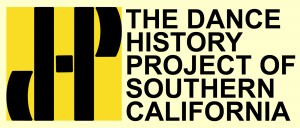Bella Lewitzky, A Brief Biography
This article was originally published in Encyclopedia Judaica, 2006
Bella Lewitzky (1916-2004), dancer, choreographer, educator, arts activist. She was born to Russian-Jewish parents near California’s Mojave Desert at the socialist commune Llano del Rio. Raised in San Bernardino, her parent’s commitment to education, political engagement and art despite poverty, became hallmarks of her life and work. At eighteen, she moved to Los Angeles to dance, joining the Horton Dance Group in 1935. Critical acclaim soon followed. Lester Horton built his technique and choreography on her technical prowess and ability to extend and clarify his ideas.
In 1950 Lewitzky and her husband, architect and former Horton dancer Newell Reynolds, along with other associates, left Horton over artistic and management concerns. Hailed as a compellingly dramatic dancer in Horton works like “Salome” (1937) and “The Beloved,” (1948), her style evolved. Calling herself a “kinetic thinker,” her non-linear, modernist explorations of pure motion now evoked the human condition or social commentary through the imagery of sculpted, gravity-defying movement. A renowned master teacher, her discerning analysis and concern with injury prevention cultivated dancers of stunning strength, control and expressive range.
From 1956-74, she was Dance Chair at Idyllwild School of Music and the Arts, and from 1969-74, founder and Dean of the School of Dance at California Institute of the Arts. In 1968 she taught for two months at the Batsheva and Bat-Dor Dance Company schools. In the 1970’s she helped originate the National Endowment for the Arts’ Artists in the Schools Program, teaching movement for children in support of academics as skillfully and engagingly as she taught professionals.
The Lewitzky Dance Company was founded in 1966, continuing until 1997, with extensive U.S. and international tours. She often sought the challenge of artistic collaborations. Newell Reynolds’ transparent plexiglass sheets formed multi-leveled, mid-air dance platforms for “Spaces Between” (1974). Fashion designer Rudi Gernreich created dynamic costumes for “Inscape” (1976). In 1951, she was subpoenaed by the House Un-American Activities Committee for work including integrating local ballet schools. “Uncooperative,” she was blacklisted from the film work that supplemented her income, enduring several years of continued intimidation. In 1990, the National Endowment for the Arts began requiring grant recipients to sign an anti-obscenity clause. Guided by conscience and fearing a new era of censorship, she refused to sign, successfully sued the NEA to eliminate the clause and regained her $72,000 grant.
Her integrity and forthright eloquence made her one of her generation’s most important spokespersons on the importance of dance, art and freedom. Committed to living, creating and sustaining a company far from the acknowledged dance center of New York, she employed her dancers year-round at union scale with medical benefits for over twenty years, a rarity in American dance, but in keeping with Lewitzky’s passionate dedication to valuing society’s artists. Numerous grants and awards include a 1977 Guggenheim fellowship, a 1997 National Medal of Arts from President Bill Clinton and five honorary doctorates. She was designated by the Dance Heritage Coalition as one of America’s Irreplaceable Dance Treasures.
BIBLIOGRAPHY
Eichenbum, Rose. Masters of Movement, Portraits of America’s Great Choreographers. Washington: Smithsonian Books, 2004
Goodman, Karen. Interview with Nora Reynolds Daniel, Lewitzky’s daughter and former dancer, unpublished. By phone, Los Angeles, March 24, 2005.
Goodman, Karen. Interview with John Pennington, former Lewitzky dancer, unpublished. By phone, Los Angeles, March 23, 2005.
Moore, Elvi. “Bella Lewitzky: A Legend Turned Real.” Dance Chronicle, 1978, Volume 2, pp.1-79.
Segal, Lewis. Obituary, “Bella Lewitzky, 88; Innovative Dancer and Choreographer,” Los Angeles Times, July 17, 2004, p. B13.
Smith, Richard Candida. A Life In Motion. Oral History of Bella Lewitzky completed under the auspices of the Oral History Program, University of California, Los Angeles, Regents of the University of California, 1997.
Warren, Larry. Lester Horton, Modern Dance Pioneer. New York: Marcel Dekker Inc., 1977.
ENCYCLOPAEDIA JUDAICA, Second Edition, Volume 5. © 2006.
The Gale Group. All rights reserved.




